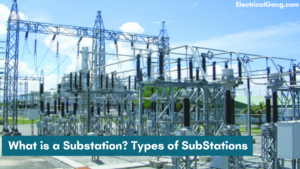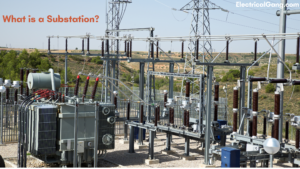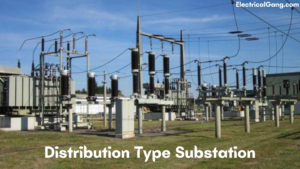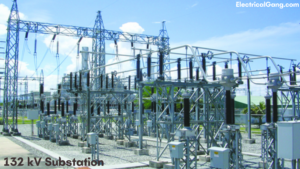
Today we will see how many types of substations are used in the transmission line of which we will get the complete information today.
Currently, the demand for electricity in every city and village is increasing very fast and this can be met by power generating substations. Our India has various types of power-generating substations like nuclear, thermal, and hydropower stations. Substations can be constructed at different locations depending on the availability of different resources.
But these locations cannot be closer to the load center. Actual power consumption can be done through the load center. That is why it is important to transmit power from the substation to the load center locations. That is why this task requires a high and long transmission network.
We all know that power generation is done at a low level. However, providing electricity at high-voltage levels is cheaper. To maintain high and low voltage levels a lot of switching as well as transformation stations have to be produced at the place of production and at the end of customers.
These two stations are commonly referred to as electrical substations. In today’s article, we will see what is Substation? And today we will talk about the types of substations.
Suggested Read: Electrical Substation Components And Their Workings
What is a Substation?

A substation is a high-voltage electrical system and can be used to control generators, electrical circuits, equipment, etc. Some types of substations are not small in size which includes inbuilt transfer as well as its associated switches. Other types of substations with transformers, equipment, circuit breakers, and switches are very wide in different types of substations.
Types of Substations:
The list of different types of substations is as follows:
| Sr. No. | Types of Substations |
| #1. | Step-up Type Substation |
| #2. | System Stations |
| #3. | Customer Substation |
| #4. | Distribution Type Substation |
| #5. | Step-down Type Substation |
| #6. | Underground Distribution Substation |
| #7. | Switchyard |
| #8. | 11kv Substation |
| #9. | 220 kV Substation |
| #10. | 132 kV Substation |
#1. Step-up Type Substation:

In the step-up type substation, it receives power supply from the nearest power plant and a large power transformer is used to increase the voltage level for transmission of power in the remote area. Power can be transmitted to the transmission line in the substation using the transmission bus.
This substation can also knock on the incoming power received by the generation plant. The power obtained is used to operate the equipment in the plant as well as to supply power. A substation includes a circuit breaker for switch generation as well as a transmission circuit inside and outside the service as required.
#2. System Stations:
This type of substation contains a large amount of power transfer in all the stations and is known as a system station. Such substations do not only offer power transformers but also other voltage exchangers.
Typically these stations provide endpoints to the transmission lines generated from the switchyard and provide electrical energy to the circuit supplying the transformer station. It is important for long-term consistency. Such substations are extremely expensive for strategic services as well as construction as well as maintenance.
Suggested Read: Difference Between Step-up And Step-Down Transformer
#3. Customer Substation:
Such substations serve as the main source of electricity for a particular type of business client. The business case, as well as the technical requirement, depends very much on the needs of the customers.
#4. Distribution Type Substation:

This type of substation is used where the main voltage distribution is lowered to supply electricity to the customer using the Distribution Network. The voltage of any two-phase will be 400 volts and the voltage between neutral and any phase will be 230 volts.
#5. Step-down Type Substation:
Step-down Type Substation is placed at different points in the electrical network. So that different parts of the network can be easily connected and are the source of the sub-transmission or distribution line. With the help of this type of substation, the transmission voltage can be converted to sub-transmission voltage (69kV). Transformed voltage lines can provide a source for a distribution substation.
In some cases power tapping is done from the line of the transmission line to be used in industrial capacity along the way or otherwise, the distribution will supply power to the substation.
#6. Underground Distribution Substation:
The construction of substations in the city area requires a large amount of space but usually, they do not have any space for the construction of substations. To overcome such a problem, installing the substation underground reduces the need for space, and part of the ground level can also be used for other constructions like buildings or other shopping malls, etc.
The main idea of an underground substation is to offer the best conventional substation by reducing the space above ground.
#7. Switchyard:
The switchyard is the mediator in transmission as well as generation and an identical voltage can be maintained in the switchyard. The main purpose of a switchyard is to supply the energy generated from the power plant to the nearest transmission line or power grid at a certain level of voltage.
#8. 11kv Substation:
The main purpose of this substation is to collect high-voltage energy transmitted from the power plant or main generating station. It then reduces the voltage required for local distribution and facilitates switching. The 11kv substation includes an electrical isolator, lightning arrester, step-down transformer, CT metering, circuit breaker, and capacitor bank.
#9. 220 kV Substation:
The 220kVA substation here is the power capacity used by the step-down transformer in the substation, and it represents the most obvious power that a step-down transformer can deliver. The received voltage level of this substation will be 220kV.
#10. 132 kV Substation:

132kV is the rating of a step-down transformer in which 132kV is the primary voltage. Typically such type transformers are operated in transmission-type substations where the voltage has to go down for additional distribution.
Similarly, some substations are classified on the basis of their importance and design, nature of duties, service rendered, and operating voltage.
- The nature of duty-based substations is step-up, primary grid substation, and step-down.
- Service render-based substation service render which includes a transformer, switching, and converting substation.
- Operating voltage-based substations include high voltage, extra-high voltage, and ultra-high voltage substations.
- Substations based on importance are grid and town substations.
- Substations based on the design include indoor, outdoor, foundation-mounted, and pole-mounted substations.
Most Commonly Asked Questions:

What are substations and their classification?
The substation transfers power from the power plant to the customer’s home. It includes a wide variety of equipment such as power transformers, generators, and power cables. Which helps in power transmission.
How many types of substations are there?
| Sr. No. | Types of SubStations |
| #1. | Step-up Type Substation |
| #2. | System Stations |
| #3. | Customer Substation |
| #4. | Distribution Type Substation |
| #5. | Step-down Type Substation |
| #6. | Underground Distribution Substation |
| #7. | Switchyard |
| #8. | 11kv Substation |
| #9. | 220 kV Substation |
| #10. | 132 kV Substation |
What are the types of transformer substations?
The transformer substation is an important element of any electrical power system and is the heart of this transmission network. It can be mainly classified into four sections a step-up substation, a primary grid substation, a secondary substation, and a distribution substation.
What are the functions of substations?
The main purpose of the substation is to ‘high state down’ high voltage electricity from the transmission system to low voltage electricity. So that it can be easily supplied to homes and businesses through our distribution lines.
Suggested Read –
- Difference Between MCB and MCCB | MCB VS MCCB
- Vizio TV Remote Not Working? | Here’s How to Fix It
- How to Fix YouTube TV Freezing Issues in Easy Steps
- How to Solve LG Content Store Not Working Problem?
- How to Fix Samsung Soundbar Remote Not Working Problem?
Final Thoughts :
Thus we have discussed different types of substations. From the above information, we can conclude that the substation is an important part of the power grid and makes a significant connection between the transmission, generating, distribution as well as load point.